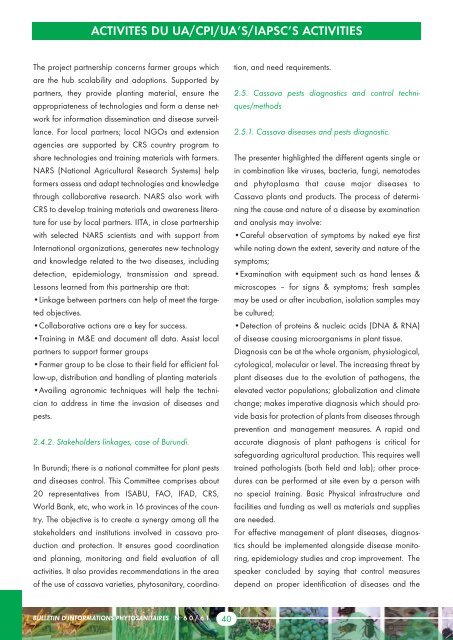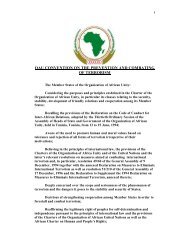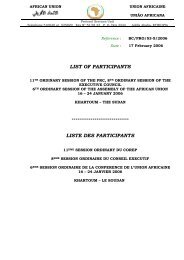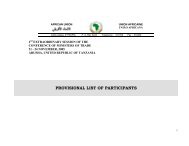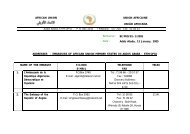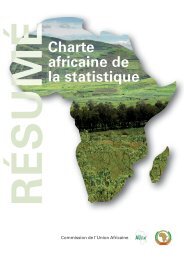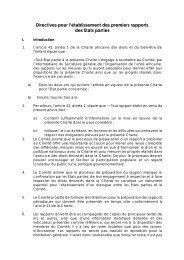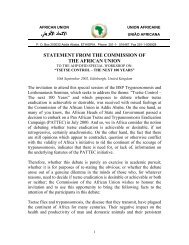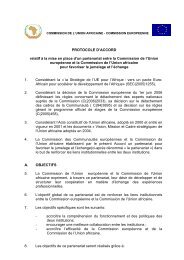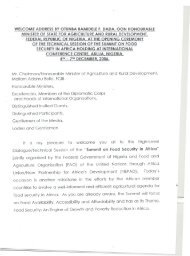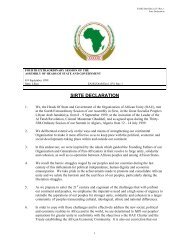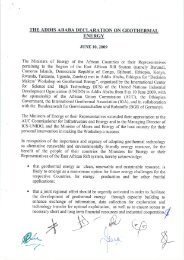BULLETIN D'INFORMATIONS PHYTOSANITAIRES ... - Union africaine
BULLETIN D'INFORMATIONS PHYTOSANITAIRES ... - Union africaine
BULLETIN D'INFORMATIONS PHYTOSANITAIRES ... - Union africaine
- No tags were found...
Create successful ePaper yourself
Turn your PDF publications into a flip-book with our unique Google optimized e-Paper software.
ACTIVITES DU UA/CPI/UA’S/IAPSC’S ACTIVITIESThe project partnership concerns farmer groups whichare the hub scalability and adoptions. Supported bypartners, they provide planting material, ensure theappropriateness of technologies and form a dense networkfor information dissemination and disease surveillance.For local partners; local NGOs and extensionagencies are supported by CRS country program toshare technologies and training materials with farmers.NARS (National Agricultural Research Systems) helpfarmers assess and adapt technologies and knowledgethrough collaborative research. NARS also work withCRS to develop training materials and awareness literaturefor use by local partners. IITA, in close partnershipwith selected NARS scientists and with support fromInternational organizations, generates new technologyand knowledge related to the two diseases, includingdetection, epidemiology, transmission and spread.Lessons learned from this partnership are that:•Linkage between partners can help of meet the targetedobjectives.•Collaborative actions are a key for success.•Training in M&E and document all data. Assist localpartners to support farmer groups•Farmer group to be close to their field for efficient follow-up,distribution and handling of planting materials•Availing agronomic techniques will help the technicianto address in time the invasion of diseases andpests.2.4.2. Stakeholders linkages, case of Burundi.In Burundi; there is a national committee for plant pestsand diseases control. This Committee comprises about20 representatives from ISABU, FAO, IFAD, CRS,World Bank, etc, who work in 16 provinces of the country.The objective is to create a synergy among all thestakeholders and institutions involved in cassava productionand protection. It ensures good coordinationand planning, monitoring and field evaluation of allactivities. It also provides recommendations in the areaof the use of cassava varieties, phytosanitary, coordination,and need requirements.2.5. Cassava pests diagnostics and control techniques/methods2.5.1. Cassava diseases and pests diagnostic.The presenter highlighted the different agents single orin combination like viruses, bacteria, fungi, nematodesand phytoplasma that cause major diseases toCassava plants and products. The process of determiningthe cause and nature of a disease by examinationand analysis may involve:•Careful observation of symptoms by naked eye firstwhile noting down the extent, severity and nature of thesymptoms;•Examination with equipment such as hand lenses µscopes – for signs & symptoms; fresh samplesmay be used or after incubation, isolation samples maybe cultured;•Detection of proteins & nucleic acids (DNA & RNA)of disease causing microorganisms in plant tissue.Diagnosis can be at the whole organism, physiological,cytological, molecular or level. The increasing threat byplant diseases due to the evolution of pathogens, theelevated vector populations; globalization and climatechange; makes imperative diagnosis which should providebasis for protection of plants from diseases throughprevention and management measures. A rapid andaccurate diagnosis of plant pathogens is critical forsafeguarding agricultural production. This requires welltrained pathologists (both field and lab); other procedurescan be performed at site even by a person withno special training. Basic Physical infrastructure andfacilities and funding as well as materials and suppliesare needed.For effective management of plant diseases, diagnosticsshould be implemented alongside disease monitoring,epidemiology studies and crop improvement. Thespeaker concluded by saying that control measuresdepend on proper identification of diseases and the<strong>BULLETIN</strong> D’INFORMATIONS <strong>PHYTOSANITAIRES</strong> N OS 60/6140


